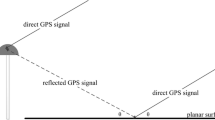Abstract
Measurements of soil moisture are important for studies of climate and weather forecasting, flood prediction, and aquifer recharge studies. Although soil moisture measurement networks exist, most are sparsely distributed and lack standardized instrumentation. Measurements of soil moisture from satellites have extremely large spatial footprints (40–60 km). A methodology is described here that uses existing networks of continuously-operating GPS receivers to measure soil moisture fluctuations. In this technique, incoming signals are reflected off and attenuated by the ground before reception by the GPS receiver. These multipath reflections directly affect signal-to-noise ratio (SNR) data routinely collected by GPS receivers, creating amplitude variations that are a function of ground reflectivity and therefore soil moisture content. After describing this technique, multipath reflection amplitudes at a GPS site in Tashkent, Uzbekistan are compared to estimates of soil moisture from the Noah land surface model. Although the GPS multipath amplitudes and the land surface model are uncalibrated, over the 70-day period studied, they both rise sharply following each rainfall event and slowly decrease over a period of ∼10 days.





Similar content being viewed by others
References
Bilich A (2006) Improving the precision and accuracy of geodetic GPS: applications to multipath and seismology. Doctoral dissertation, University of Colorado
Bhark EW, Small EE (2003) Association between plant canopies and the spatial variability of infiltration in shrubland and grassland of the Chihuahuan desert, New Mexico. Ecosystems 6:185–196
Chen F, Dudhia J (2001) Coupling an advanced land-surface/hydrology model with the Penn State/NCAR MM5 modeling system part I: model implementation and sensitivity. Mon Wea Rev 129:569–585
Entekhabi D, Rodriguez-Iturbe I (1994) Analytical framework for the characterization of the space-time variability of soil moisture. Adv Water Res 17:35–45
Gutmann ED, Small EE (2005) The effect of soil hydraulic properties vs. soil texture in land surface models. Geophys Res Lett, 32, L02402, doi: 10.1029/2004GL021843
Gutmann ED, Small EE (2007) A comparison of land surface model soil hydraulic properties estimated by inverse modeling and pedotransfer functions. Water Resour Res 43(5) W05418, doi:10.1029/2006WR005135
Katzberg S, Torres O, Grant M, Masters D (2006) Utilizing calibrated GPS reflected signals to estimate soil reflectivity and dielectric constant: results from SMEX02. Remote Sens Environ 100(1):17–28
Kurc, SA, Small EE (2005) Dynamics of evapotranspiration in semiarid grassland and shrubland during the summer monsoon season, central New Mexico. Water Resour Res 40 W09305, doi:10.1029/2004WR003068
Mahfouf JF, Ciret C, Ducharne A, Irannejad P, Noilhan J, Shao Y, Thornton P, Xue Y, Yang Z (1996) Analysis of transpiration results from the RICE and PILPS workshop. Glob Planet Change 13(1):73–88
Masters D, Axelrad P, Katzberg S (2004) Initial results of land-reflected GPS bistatic radar measurements in SMEX02. Rem Sens Envir 92(4):507–520
Njoku E, O’Neill P (1982) Multifrequency radiometer measurements of soil moisture. IEEE Trans Geosci Remote Sens 20:468–475
Njoku EG, Entekhabi D (1996) Passive microwave remote sensing of soil moisture. J Hydrol 184:101–129
Robock A, Vinnikov K, Srinivasan G, Entin J, Hollinger S, Speranskaya N, Liu S, Amkhai A (2000) The Global Soil Moisture Data Bank. Bull Am Meteor Soc 81:1281–1299
Rodell M, et al (2004) The global land data assimilation system. Bull Am Meteor Soc 85:381–394
Rodriguez-Iturbe I (2000) Ecohydrology: a hydrologic perspective of climate–soil–vegetation dynamics. Water Resour Res 36(1):3–9
Small EE (2005) Climatic controls on diffuse groundwater recharge in arid and semiarid environments. Water Resour Res 41(4), W04012, 10.1029/2004WR003193
Teuling AJ, Seneviratne S, Williams C, Troch P (2006) Observed timescales of evapotranspiration response to soil moisture. Geophys Res Lett, 33(23), doi:10.1029/2006GL028178
Ulaby F, Moore R, Fung A (1986) Microwave remote sensing, active and passive, vol. III: from theory to applications. Artech House, Norwood
Acknowledgments
This research was supported by National Aeronautics and Space Administration SENH 154–0351. National Science Foundation EAR-0003943 and EAR-0337206 also contributed to its development. We are grateful to the operators of TASH and GFZ (Markus Ramatschi) for providing data and information about the site. The TASH data are available from CDDIS.
Author information
Authors and Affiliations
Corresponding author
Rights and permissions
About this article
Cite this article
Larson, K.M., Small, E.E., Gutmann, E. et al. Using GPS multipath to measure soil moisture fluctuations: initial results. GPS Solut 12, 173–177 (2008). https://doi.org/10.1007/s10291-007-0076-6
Received:
Accepted:
Published:
Issue Date:
DOI: https://doi.org/10.1007/s10291-007-0076-6




